考研英语阅读中频繁出现的经济类题型
考研英语阅读关于经济
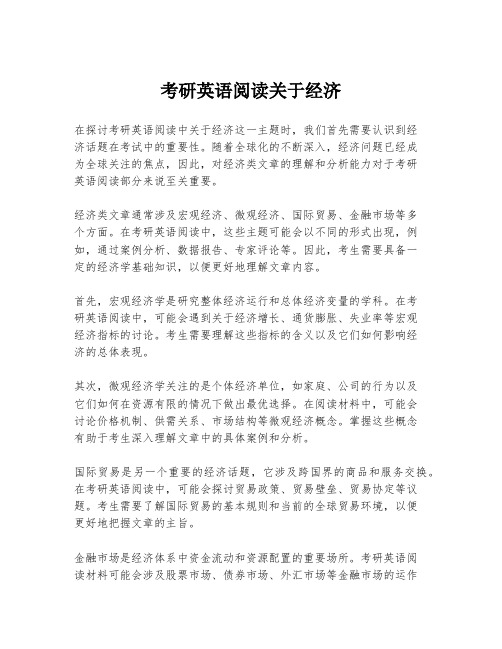
考研英语阅读关于经济在探讨考研英语阅读中关于经济这一主题时,我们首先需要认识到经济话题在考试中的重要性。
随着全球化的不断深入,经济问题已经成为全球关注的焦点,因此,对经济类文章的理解和分析能力对于考研英语阅读部分来说至关重要。
经济类文章通常涉及宏观经济、微观经济、国际贸易、金融市场等多个方面。
在考研英语阅读中,这些主题可能会以不同的形式出现,例如,通过案例分析、数据报告、专家评论等。
因此,考生需要具备一定的经济学基础知识,以便更好地理解文章内容。
首先,宏观经济学是研究整体经济运行和总体经济变量的学科。
在考研英语阅读中,可能会遇到关于经济增长、通货膨胀、失业率等宏观经济指标的讨论。
考生需要理解这些指标的含义以及它们如何影响经济的总体表现。
其次,微观经济学关注的是个体经济单位,如家庭、公司的行为以及它们如何在资源有限的情况下做出最优选择。
在阅读材料中,可能会讨论价格机制、供需关系、市场结构等微观经济概念。
掌握这些概念有助于考生深入理解文章中的具体案例和分析。
国际贸易是另一个重要的经济话题,它涉及跨国界的商品和服务交换。
在考研英语阅读中,可能会探讨贸易政策、贸易壁垒、贸易协定等议题。
考生需要了解国际贸易的基本规则和当前的全球贸易环境,以便更好地把握文章的主旨。
金融市场是经济体系中资金流动和资源配置的重要场所。
考研英语阅读材料可能会涉及股票市场、债券市场、外汇市场等金融市场的运作机制和相关政策。
考生需要对金融市场的基本概念和功能有一定的了解,这样才能准确把握文章的要点。
最后,考生在准备考研英语阅读时,还应该注意培养自己的批判性思维能力。
这意味着不仅要理解文章中的观点和论据,还要能够分析和评估这些观点的合理性。
通过这种方式,考生可以更全面地理解经济类文章,提高自己的阅读和分析能力。
综上所述,考研英语阅读中关于经济的文章要求考生具备一定的经济学知识,并且能够运用批判性思维来分析和理解文章内容。
通过系统地学习和练习,考生可以提高自己在这一领域的阅读能力,为考研英语的成功打下坚实的基础。
考研英语经济类阅读理解及参考答案

考研英语经济类阅读理解及参考答案阅读理解,我们在考研之前英语考试上造就做过了,但是还没有针对性地做过经济的吧。
下面是店铺给大家整理的考研英语经济类阅读理解及答案,供大家参阅!考研英语经济类阅读理解及答案:Crude awakeningA battle between two energy exchangesOPEN-OUTCRY trading is supposed to be a quaint, outdated practice, rapidly being replaced by sleeker, cheaper electronic systems. Try telling that to theNew York Mercantile Exchange (NYMEX), the world's largest commodities exchange. On November 1st the NYMEX opened an open-outcry pit in Dublin to handle Brent crude futures, the benchmark contract for pricing two-thirds of the world's oil.The NYMEX is trying to snatch liquidity from London's International Petroleum Exchange (IPE), which trades the most Brent contracts; the New York exchange has hitherto concentrated on West Texas Intermediate, an American benchmark grade. The new pit is a response to the IPE's efforts to modernise. On the same day as NYMEX traders started shouting Brent prices in Dublin, the IPE did away with its morning open-outcry session: now such trades must be electronic, or done in the pit after lunch.The New York exchange claims that customers, such as hedge funds or energy companies, prefer open-outcry because it allows for more liquidity. Although most other exchanges are heading in the opposite direction, in commodity markets such as the NYMEX, pressure from "locals"--self-employed traders--is helping to prop up open-outcry, although some reckon that customers pay up to five times as much as with electronicsystems. Even the IPE has no plans to abolish its floor. Only last month it signed a lease, lasting until 2011, for its trading floor in London.Dublin's new pit is "showing promise", says Rob Laughlin, a trader with Man Financial, despite a few technical glitches. On its first day it handled 5,726 lots of Brent (each lot, or contract, is 1,000 barrels), over a third of the volume in the IPE's new morning electronic session. By the year's end, predicts Mr Laughlin, it should be clear whether the venture will be viable. It would stand a better chance if it moved to London. It may yet: it started in Ireland because regulatory approval could be obtained faster there than in Britain.Ultimately, having both exchanges offering similar contracts will be unsustainable. Stealing liquidity from an established market leader, as the NYMEX is trying to do, is a hard task. Eurex, Europe's largest futures exchange, set up shop in Chicago this year, intending to grab American Treasury-bond contracts from the Chicago Board of Trade. It has made little headway. And the NYMEX has dabbled in Brent contracts before, without success.Given the importance of liquidity in exchanges, why do the IPE and the NYMEX not band together? There have been merger talks before, and something might yet happen. Some say that the freewheeling NYMEX and the more staid IPE could never mix. For now, in any case, the two exchanges will slug it out--across the Irish Sea as well as across the Atlantic.--------------------------------------------------------------------------------Economist; 11/6/2004, Vol. 373 Issue 8400, p78-78, 1/2p, 1c 注(1):本文选自Economist;11/6/2004, p78-78, 1/2p, 1c;注(2):本文习题命题模仿2001年真题text 2第1题(1),text 4第2题(2),text 1第2题(4),2002年真题text 2第2题(3),text 3第4题(5);1.The NYMEX and IPE are___________.[A] both using open outcry trading as a major trading form[B] partners that are reciprocal in their business activities[C] rivals that are competing in the oil trading market[D] both taking efforts to modernize their trading practice2.According to the author, one of the reasons that the NYMEX takes open-outcry tradingis__________.[A] the preference of its customers[B] the standard practice of energy exchange[C] the long tradition of this trading practice[D] the nostalgic feeling it arouses3.The word “glitches” (Line 2, Paragraph 4) most probably means_________.[A] backwardness[B] disappointments[C] engineers[D] problems4.From Paragraph 4 we can infer that_________.[A] trading volume in the IPE's new morning electronic session is falling[B] London is a better business location for energy exchanges than Dublin[C] Britain’s regulators are less efficient than those of Ireland[D] the Dublin pit of the NYMEX will be more prosperous next year5.We can draw a conclusion from the text that___________.[A] it’s very unlikely that the NYMEX and the IPE could combine their businesses[B] the NYMEX will fail in Ireland as many precedents have shown[C] the two energy exchanges will figure out a way to cooperate with each other[D] the market environment for both energy exchanges is getting better答案:C A D B A篇章剖析本文介绍了两家能源交易所之间的商战。
考研英语真题阅读 经济发展
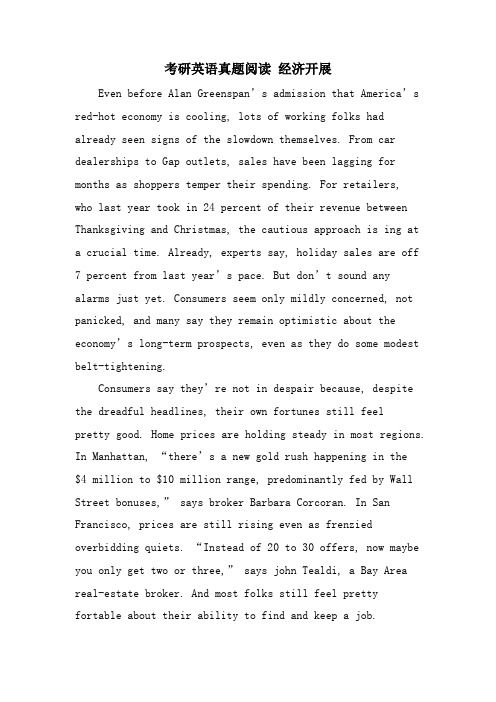
考研英语真题阅读经济开展Even before Alan Greenspan’s admission that America’s red-hot economy is cooling, lots of working folks had already seen signs of the slowdown themselves. From car dealerships to Gap outlets, sales have been lagging for months as shoppers temper their spending. For retailers, who last year took in 24 percent of their revenue between Thanksgiving and Christmas, the cautious approach is ing ata crucial time. Already, experts say, holiday sales are off7 percent from last year’s pace. But don’t sound any alarms just yet. Consumers seem only mildly concerned, not panicked, and many say they remain optimistic about the economy’s long-term prospects, even as they do some modest belt-tightening.Consumers say they’re not in despair because, des pite the dreadful headlines, their own fortunes still feelpretty good. Home prices are holding steady in most regions. In Manhattan, “there’s a new gold rush happening in the $4 million to $10 million range, predominantly fed by Wall Street bonuses,” says broker Barbara Corcoran. In San Francisco, prices are still rising even as frenzied overbidding quiets. “Instead of 20 to 30 offers, now maybe you only get two or three,” says john Tealdi, a Bay Area real-estate broker. And most folks still feel prettyfortable about their ability to find and keep a job.Many folks see silver linings to this slowdown.Potential home buyers would cheer for lower interest rates. Employers wouldn’t mind a little fewer bubbles in the job market. Many consumers seem to have been influenced bystock-market swings, which investors now view as a necessary ingredient to a sustained boom. Diners might see an upside, too. Getting a table at Manhattan’s hot newAlain Ducasse restaurant need to be impossible. Not anymore. For that, Greenspan & Co. may still be worth toasting.31. By “Ellen Spero isn't biting her nails just yet” (Line 1, Paragraph 1), the author means[A] Spero can hardly maintain her business.[B] Spero is too much engaged in her work.[C] Spero has grown out of her bad habit.[D] Spero is not in a desperate situation.32. How do the public feel about the current economic situation?[A] Optimistic. [B] Confused. [C] Carefree. [D] Panicked.33. When mentioning “the $4 million to $10 million range” (Lines 3, Paragraph 3), the author is talkingabout[A] gold market. [B] real estate. [C] stock exchange. [D] venture investment.34. Why can many people see “silver linings”to the economic showdown?[A] They would benefit in certain ways.[B] The stock market shows signs of recovery.[C] Such a slowdown usually precedes a boom.[D] The purchasing power would be enhanced.35. To which of the following is the author likely to agree?[A] A new boom, on the horizon.[B] Tighten the belt, the single remedy.[C] Caution all right, panic not.[D] The more ventures, the more chances.名师解析31. By“Ellen Spero isn't biting her nails justyet”(Line 1, Paragraph 1), the author means通过说“艾伦·斯拜罗还不至于咬手指”(第一段第一行),作者的意思是[A] Spero can hardly maintain her business. 斯拜罗几乎无法维持自己的生意。
考研英语阅读材料汇编之经济类(1)-毙考题
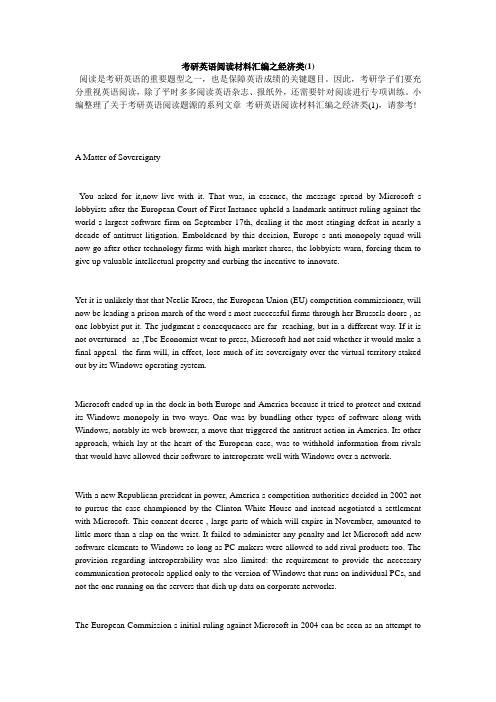
阅读是考研英语的重要题型之一,也是保障英语成绩的关键题目。因此,考研学子们要充分重视英语阅读,除了平时多多阅读英语杂志、报纸外,还需要针对阅读进行专项训练。小编整理了关于考研英语阅读题源的系列文章考研英语阅读材料汇编之经济类(1),请参考!
A Matter of Sover源自igntyWith its ruling, the court has set a precedent that means Windows is no longer simply private property with which Microsoft can do as it pleases. And this will certainly apply to any other firm that manages to build a similarly crucial and long-lasting digital monopoly. Even today, with software increasingly delivered as a service over the internet, Windows is protected by something known as the application barrier to entry , meaning that so many programs run on it that rivals have a hard time getting users and software developers to switch.
Yet it is unlikely that that Neelie Kroes, the European Union (EU) competition commissioner, will now be leading a prison march of the word s most successful firms through her Brussels doors , as one lobbyist put it. The judgment s consequences are far- reaching, but in a different way. If it is not overturned--as ,Tbe Economist went to press, Microsoft had not said whether it would make a final appeal--the firm will, in effect, lose much of its sovereignty over the virtual territory staked out by its Windows operating system.
考研英语阅读:经济类
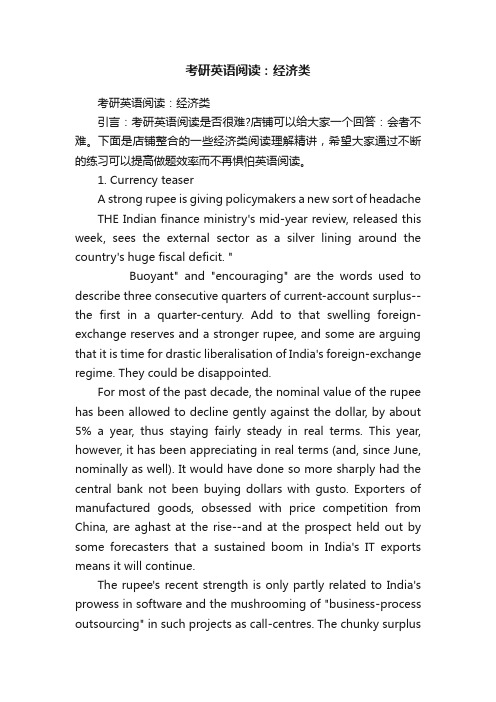
考研英语阅读:经济类考研英语阅读:经济类引言:考研英语阅读是否很难?店铺可以给大家一个回答:会者不难。
下面是店铺整合的一些经济类阅读理解精讲,希望大家通过不断的练习可以提高做题效率而不再惧怕英语阅读。
1. Currency teaserA strong rupee is giving policymakers a new sort of headacheTHE Indian finance ministry's mid-year review, released this week, sees the external sector as a silver lining around the country's huge fiscal deficit. "Buoyant" and "encouraging" are the words used to describe three consecutive quarters of current-account surplus--the first in a quarter-century. Add to that swelling foreign-exchange reserves and a stronger rupee, and some are arguing that it is time for drastic liberalisation of India's foreign-exchange regime. They could be disappointed.For most of the past decade, the nominal value of the rupee has been allowed to decline gently against the dollar, by about 5% a year, thus staying fairly steady in real terms. This year, however, it has been appreciating in real terms (and, since June, nominally as well). It would have done so more sharply had the central bank not been buying dollars with gusto. Exporters of manufactured goods, obsessed with price competition from China, are aghast at the rise--and at the prospect held out by some forecasters that a sustained boom in India's IT exports means it will continue.The rupee's recent strength is only partly related to India's prowess in software and the mushrooming of "business-process outsourcing" in such projects as call-centres. The chunky surpluson invisibles owes more to remittances: non-resident Indians, attracted by the stability of the rupee and its higher interest rates, have been moving their offshore deposits back home. Similarly, Indian companies are borrowing more in dollars without selling rupees forward to hedge repayments. The trade deficit, meanwhile, has been shrinking, as imports grow slowly.The inflows have boosted foreign-exchange reserves by some $20 billion this year, to $66 billion, or 12 months'-worth of imports. The size of this cushion has triggered some calls for further liberalisation of the labyrinthine foreign-exchange controls that India still maintains, despite the move in 1993 towards rupee convertibility for trade purposes. In recent months, some controls have duly been eased. It is now simpler, for example, for individuals to open foreign-currency bank accounts, and for travellers to get hold of foreign exchange. And non-resident Indians have been allowed to take out money acquired through inheritance, or from rents and dividends.Some commentators have taken all this as a harbinger of full capital-account convertibility. That is not on the cards. The experience of 1991, when India ran out of money, has left the central bank prone to caution--an approach it felt was vindicated by the East Asian crisis of 1997-98. With war in Iraq looming and a turbulent oil market, some risk aversion is understandable. India's fiscal deficit--some 10% of GDP and widening--is another reason for moving slowly. Just as one rating agency, Moody's, is considering upgrading India's external debt, another, Fitch, has warned that its local-currency rating is under threat. Nor is it certain that opening the capital account would mean a weaker rupee. It might even attract more capital inflows. As India's exporters are learning, convertibility is a two-way street.Economist; 12/7/2002, Vol. 365 Issue 8302, p73, 1/3p注(1):本文选自Economist;12/7/2002, p73, 1/3p;注(2):本文习题命题模仿2002年真题text 2第2题(1),text 5第3题(2),1995年真题text 2第4题(3),2000年真题text 4第3题(4)和1998年真题text 2第4题(5);1.The expression “silver lining” (Line 2, Paragraph 1) most probably means______.[A] a side effect[B] a favorable aspect[C] a decorative line[D] a comforting prospect2.According to the text, the appreciation of the rupee in real terms__________.[A] will lower its nominal value[B] is bad news to exporters of manufactured goods[C] means a sharper decline of its nominal value against the dollar[D] will give impetus to the development of India’s IT industry3.The current account surplus owes to the following EXCEPT_________.[A] the strength of the rupee[B] the remittances of non-resident Indians[C] the hedging activity of Indian companies[D] the growing imports4.Which of the following is true according to the text?。
考研英语阅读:经济类(4)

考研英语阅读:经济类(4)考研英语阅读:经济类Economist; 11/27/2004, Vol. 373 Issue 8403, p64-65, 2p, 1c 注(1):本文选自Economist;11/27/2004, p64-65, 2p, 1c;注(2):本文习题命题模仿2000年真题text 1第1题(1),1995年真题text 1第2题(2),2002年真题text 2第2题(3),1998年真题text 2第2题(4)和1999年真题text 1第4题(5);1.The main reason for the constant change at the top of McDonald is ________.[A] the board’s interference[B] the falling sales[C] the health problems of the chief executives[D] the constant change of its share price2.Which of the following was NOT a cause of the falling sales of McDonald?[A] the change of the chief executive[B] people’s concern about junk food[C] dirty restaurant[D] indifferent service3.The phrase “heir apparent” (Line 7, Paragraph 2) in the article most probablymeans____________.[A] someone who has the same ideas, aims and style with a person[B] someone who has the unalienable right to receive the family title[C] someone who is appointed as a heir of a person[D] someone who is likely to take over a person’s position when that person leaves4.In terms of succession at the top, McDonald_________.[A] has had to made rather hasty decisions[B] prefers to appoint a new boss from within[C] acts in a quick and unreasonable way[D] surprises all the people with its decisions5.Toward McDonald’s reaction to emergencies at the top, the writer’s attitude can be said to be___________.[A] indifferent[B] doubtful[C] objective[D] praiseful答案:C A D B D篇章剖析本篇文章介绍了麦当劳高层人事接替的情况,是一篇说明文。
考研英语题型常用(15篇)

考研英语题型常用(15篇)考研英语题型常用(15篇)考研英语题型1考研英语一的满分是100分。
第一部分是英语学问运用,共20小题,每小题0.5分,共10分。
该题型是四选一选择题,更详细的说是在一篇240-280个词的文章中,留出20个空,考生选出最佳答案进行补全。
考生是在答题卡上作答的,记得带铅笔哦。
其次部分是阅读理解,共30小题,每小题2分,共60分。
该部分的题型是由A、B、C三节组成,A节(20小题);B 节(5小题);C节(5小题)。
A节是选择题,20小题共40分,考生在答题卡1上作答。
B节是5小题共10分,每次考试从3种备选题型中选择1种进行考查。
考生在答题卡1上作答。
C节是翻译题,5小题共10分。
第三部分是写作,该部分由A、B两节组成,共30分。
A节是写一篇约100个词的应用性短文,共10分,考生在答题卡2上作答。
B节是写一篇160-200个词的短文,共20分,考生在答题卡2上作答。
拓展阅读:考研英语一考试答题技巧考研英语分为两个阶段,考场之上最忌“抢答”首先要做好答题前的预备:正式开头答题前几分钟,同学们就会拿到英语试卷。
从考试要求来说,正式考试开头之前,是肯定不允许动笔答题的。
这时,首先要快速地整体扫瞄一下试卷,大致推断一下对于自己来说试卷的难度。
这里要特殊留意留意两个部分:一是阅读理解,通过语篇词汇和话题,感觉一下难度,同时要确定哪几篇是自己感觉能读懂和要尽力全部答对的,哪些可能单从语篇词汇就超出了自己的力量,不能“硬攻”,而更要讲究答题技巧的;二是看一看书面表达题目,大致勾画出一篇文章结构,特殊是想一想需要使用的词汇,有哪些就在脑子里,哪些一时想不起来。
对于这样的词,可以随着答题进程,借助试卷信息得到提示。
不要“长”答,要合理安排答题时间在第一个阶段的'英语考试中,掌握好答题节奏,合理利用时间,这一点特别重要。
阅读理解部分由于语篇多,词汇量和阅读量都大,因此比较耗时,但千万不能在这里“恋战”。
考研英语阅读理解精选之经济类

(三)经济类 Plumper How does the country’s economy compare with those of the EU? SOME of the concerns surrounding Turkey’s application to join the European Union, to be voted on by the EU’s Council of Ministers on December 17th, are economic-in particular, the country’s relative poverty. Its GDP per head is less than a third of the average for the 15 pre-2004 members of the EU. But it is not far off that of one of the ten new members which joined on May 1st 2004 (Latvia), and it is much the same as those of two countries, Bulgaria and Romania, which this week concluded accession talks with the EU that could make them full members on January 1st 2007. Furthermore, the country’s recent economic progress has been, according to Donald Johnston, the secretary-general of the OECD, "stunning". GDP in the second quarter of the year was 13.4% higher than a year earlier, a rate of growth that no EU country comes close to matching. Turkey’s inflation rate has just fallen into single figures for the first time since 1972, and this week the country reached agreement with the IMF on a new three-year, $10 billion economic programme that will, according to the IMF’s managing director, Rodrigo Rato, "help Turkey... reduce inflation toward European levels, and enhance the economy’s resilience". Resilience has not historically been the country’s economic strong point. As recently as 2001, GDP fell by over 7%. It fell by more than 5% in 1994, and by just under 5% in 1999. Indeed, throughout the 1990s growth oscillated like an electrocardiogram recording a violent heart attack. This irregularity has been one of the main reasons (along with red tape and corruption) why the country has failed dismally to attract much-needed foreign direct investment. Its stock of such investment (as a percentage of GDP) is lower now than it was in the 1980s, and annual inflows have scarcely ever reached $1 billion (whereas Ireland attracted over $25 billion in 2003, as did Brazil in every year from 1998 to 2000). One deterrent to foreign investors is due to disappear on January 1st 2005. On that day, Turkey will take away the right of virtually every one of its citizens to call themselves a millionaire. Six noughts will be removed from the face value of the lira; one unit of the local currency will henceforth be worth what 1m are now-ie, about 0.53 ($0.70). Goods will have to be priced in both the new and old lira for the whole of the year, but foreign bankers and investors can begin to look forward to a time in Turkey when they will no longer have to juggle mentally with indeterminate strings of zeros. Economist; 12/18/2004, Vol. 373 Issue 8406, p115-115, 2/5p 注(1):本⽂选⾃Economist;12/18/2004, p115-115, 2/5p; 1.What is Turkey’s economic situation now? [A] Its GDP per head is far lagging behind that of the EU members. [B] Its inflation rate is still rising. [C] Its economy grows faster than any EU member. [D] Its economic resilience is very strong. 2.We can infer from the second paragraph that__________. [A] Turkey will soon catch the average GDP level of the 15 pre-2004 EU members [B] inflation rate in Turkey used to be very high [C] Turkey’s economy will keep growing at present rate [D] IMF’s economic program will help Turkey join the EU 3.The word “oscillated” (Line 3, Paragraph 3) most probably means_________. [A] fell [B] climbed [C] developed [D] swang 4.Speaking of Turkey’s foreign direct investment, the author implies that_________. [A] it’s stock is far less than that of other countries [B] it does not have much influence on Turkey’s economic progress [C] steady GDP growth will help Turkey attract more foreign direct investment [D] Turkey’s economic resilience relies on foreign direct investment 5.We can draw a conclusion from the text that__________. [A] foreign investment environment in Turkey will become better [B] Turkey’s citizens will suffer heavy loss due to the change of the face value of the lira [C] the local currency will depreciate with the removal of six noughts from the face value [D] prices of goods will go up 篇章剖析 本篇⽂章是⼀篇说明⽂,介绍了⼟⽿其的经济状况。
2018考研英语:阅读题中的经济类文章的常识
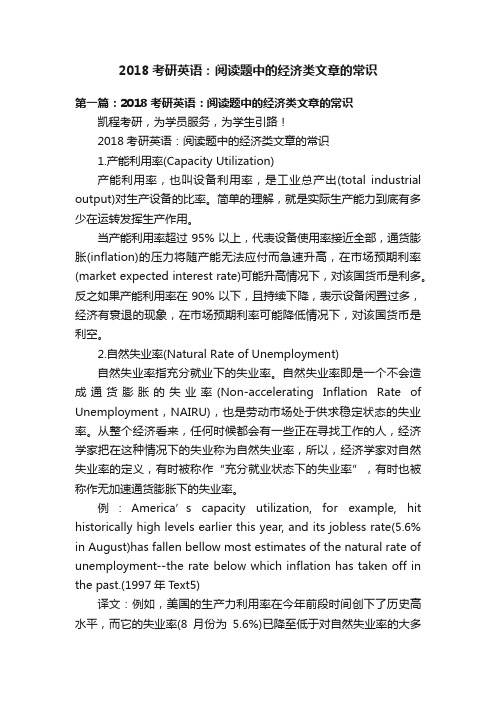
2018考研英语:阅读题中的经济类文章的常识第一篇:2018考研英语:阅读题中的经济类文章的常识凯程考研,为学员服务,为学生引路!2018考研英语:阅读题中的经济类文章的常识1.产能利用率(Capacity Utilization)产能利用率,也叫设备利用率,是工业总产出(total industrial output)对生产设备的比率。
简单的理解,就是实际生产能力到底有多少在运转发挥生产作用。
当产能利用率超过 95% 以上,代表设备使用率接近全部,通货膨胀(inflation)的压力将随产能无法应付而急速升高,在市场预期利率(market expected interest rate)可能升高情况下,对该国货币是利多。
反之如果产能利用率在 90% 以下,且持续下降,表示设备闲置过多,经济有衰退的现象,在市场预期利率可能降低情况下,对该国货币是利空。
2.自然失业率(Natural Rate of Unemployment)自然失业率指充分就业下的失业率。
自然失业率即是一个不会造成通货膨胀的失业率(Non-accelerating Inflation Rate of Unemployment,NAIRU),也是劳动市场处于供求稳定状态的失业率。
从整个经济看来,任何时候都会有一些正在寻找工作的人,经济学家把在这种情况下的失业称为自然失业率,所以,经济学家对自然失业率的定义,有时被称作“充分就业状态下的失业率”,有时也被称作无加速通货膨胀下的失业率。
例:America’s capacity utilization, for example, hit historically high levels earlier this year, and its jobless rate(5.6% in August)has fallen bellow most estimates of the natural rate of unemployment--the rate below which inflation has taken off in the past.(1997年T ext5)译文:例如,美国的生产力利用率在今年前段时间创下了历史高水平,而它的失业率(8月份为5.6%)已降至低于对自然失业率的大多数估测——过去当比率低于自然失业率时,通货膨胀率已急剧上升。
历年考研英语阅读题材分类
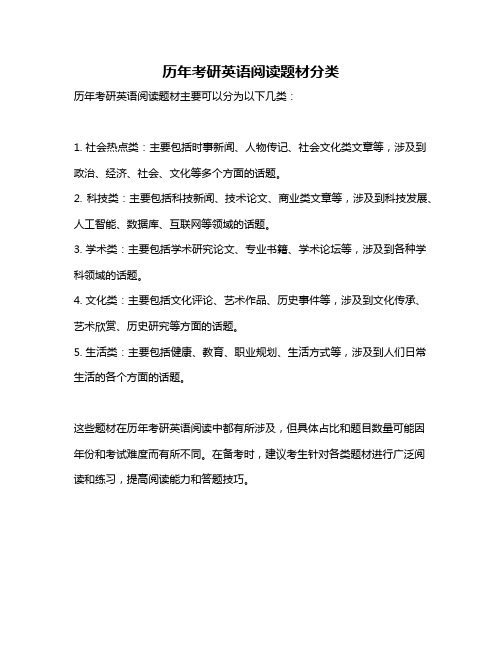
历年考研英语阅读题材分类
历年考研英语阅读题材主要可以分为以下几类:
1. 社会热点类:主要包括时事新闻、人物传记、社会文化类文章等,涉及到政治、经济、社会、文化等多个方面的话题。
2. 科技类:主要包括科技新闻、技术论文、商业类文章等,涉及到科技发展、人工智能、数据库、互联网等领域的话题。
3. 学术类:主要包括学术研究论文、专业书籍、学术论坛等,涉及到各种学科领域的话题。
4. 文化类:主要包括文化评论、艺术作品、历史事件等,涉及到文化传承、艺术欣赏、历史研究等方面的话题。
5. 生活类:主要包括健康、教育、职业规划、生活方式等,涉及到人们日常生活的各个方面的话题。
这些题材在历年考研英语阅读中都有所涉及,但具体占比和题目数量可能因年份和考试难度而有所不同。
在备考时,建议考生针对各类题材进行广泛阅读和练习,提高阅读能力和答题技巧。
考研英语阅读理解A节(传统题型)分类精讲商业经济类-(一)
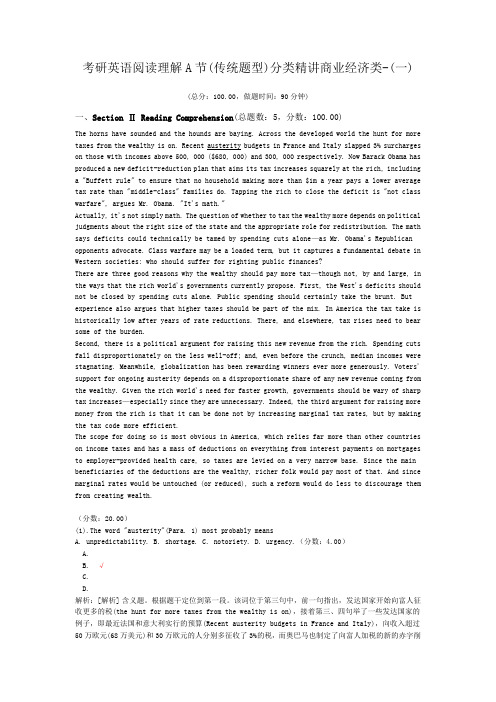
考研英语阅读理解A节(传统题型)分类精讲商业经济类-(一)(总分:100.00,做题时间:90分钟)一、Section Ⅱ Reading Comprehension(总题数:5,分数:100.00)The horns have sounded and the hounds are baying. Across the developed world the hunt for more taxes from the wealthy is on. Recent austerity budgets in France and Italy slapped 3% surcharges on those with incomes above 500, 000 ($680, 000) and 300, 000 respectively. Now Barack Obama has produced a new deficit-reduction plan that aims its tax increases squarely at the rich, including a "Buffett rule" to ensure that no household making more than $1m a year pays a lower average tax rate than "middle-class" families do. Tapping the rich to close the deficit is "not class warfare", argues Mr. Obama. "It's math."Actually, it's not simply math. The question of whether to tax the wealthy more depends on political judgments about the right size of the state and the appropriate role for redistribution. The math says deficits could technically be tamed by spending cuts alone—as Mr. Obama's Republican opponents advocate. Class warfare may be a loaded term, but it captures a fundamental debate in Western societies: who should suffer for righting public finances?There are three good reasons why the wealthy should pay more tax—though not, by and large, in the ways that the rich world's governments currently propose. First, the West's deficits should not be closed by spending cuts alone. Public spending should certainly take the brunt. But experience also argues that higher taxes should be part of the mix. In America the tax take is historically low after years of rate reductions. There, and elsewhere, tax rises need to bear some of the burden.Second, there is a political argument for raising this new revenue from the rich. Spending cuts fall disproportionately on the less well-off; and, even before the crunch, median incomes were stagnating. Meanwhile, globalization has been rewarding winners ever more generously. Voters' support for ongoing austerity depends on a disproportionate share of any new revenue coming from the wealthy. Given the rich world's need for faster growth, governments should be wary of sharp tax increases—especially since they are unnecessary. Indeed, the third argument for raising more money from the rich is that it can be done not by increasing marginal tax rates, but by making the tax code more efficient.The scope for doing so is most obvious in America, which relies far more than other countries on income taxes and has a mass of deductions on everything from interest payments on mortgages to employer-provided health care, so taxes are levied on a very narrow base. Since the main beneficiaries of the deductions are the wealthy, richer folk would pay most of that. And since marginal rates would be untouched (or reduced), such a reform would do less to discourage them from creating wealth.(分数:20.00)(1).The word "austerity"(Para. 1) most probably meansA. unpredictability.B. shortage.C. notoriety.D. urgency.(分数:4.00)A.B. √C.D.解析:[解析] 含义题。
考研英语经济类阅读理解及答案解析
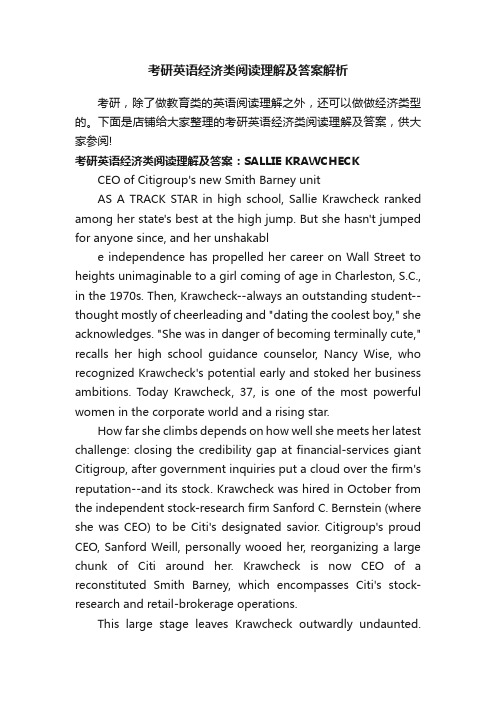
考研英语经济类阅读理解及答案解析考研,除了做教育类的英语阅读理解之外,还可以做做经济类型的。
下面是店铺给大家整理的考研英语经济类阅读理解及答案,供大家参阅!考研英语经济类阅读理解及答案:SALLIE KRAWCHECK CEO of Citigroup's new Smith Barney unitAS A TRACK STAR in high school, Sallie Krawcheck ranked among her state's best at the high jump. But she hasn't jumped for anyone since, and her unshakable independence has propelled her career on Wall Street to heights unimaginable to a girl coming of age in Charleston, S.C., in the 1970s. Then, Krawcheck--always an outstanding student--thought mostly of cheerleading and "dating the coolest boy," she acknowledges. "She was in danger of becoming terminally cute," recalls her high school guidance counselor, Nancy Wise, who recognized Krawcheck's potential early and stoked her business ambitions. Today Krawcheck, 37, is one of the most powerful women in the corporate world and a rising star.How far she climbs depends on how well she meets her latest challenge: closing the credibility gap at financial-services giant Citigroup, after government inquiries put a cloud over the firm's reputation--and its stock. Krawcheck was hired in October from the independent stock-research firm Sanford C. Bernstein (where she was CEO) to be Citi's designated savior. Citigroup's proud CEO, Sanford Weill, personally wooed her, reorganizing a large chunk of Citi around her. Krawcheck is now CEO of a reconstituted Smith Barney, which encompasses Citi's stock-research and retail-brokerage operations.This large stage leaves Krawcheck outwardly undaunted.She's relaxed and confident, with a self-deprecating sense of humor. She says she's "incredibly insecure," and has had nightmares in which she fails to win the respect of her new colleagues. But this soft-spoken humility belies a toughness present from the start. Daughter of a lawyer and sister of three more, Krawcheck learned early on to substantiate her assertions--or keep quiet."It used to get quite interesting around the dinner table," says her father Lenny, who practices law in Charleston. "Politics, relationships--you name it. It was every man for himself and awful tough to make your point." Jokes Sallie: "None of us could get a friend to come over for dinner."Krawcheck earned a journalism degree from the University of North Carolina and an M.B.A. from Columbia University. She went to work at Salomon Brothers but soon moved to Donaldson, Lufkin & Jenrette, where she met her husband Gary Appel. In 1994 Krawcheck moved to Bernstein and dived into stock research. She began covering financial-services firms in 1997 and immediately became the most influential analyst in that field. During those years, Krawcheck earned Weill's ire--and respect when she was later proved correct--by dwelling on the pitfalls of Weill's acquisition of Salomon~~~~~~~~By Daniel Kadlec Time; 12/2/2002, Vol. 160 Issue 23, p52, 1/2p, 1c注(1):本文选自Time; 12/2/2002, p52, 1/2p, 1c;注(2):本文习题命题模仿对象2003年真题Text 2;1. The author begins his article by __________.[A]making a comparison[B]posing a contrast[C]justifying an assumption[D]explaining a phenomenon2. Krawcheck was chosen the CEO of the Smith Barney because ___________.[A]the CEO of the Citigroup trusted her[B]she was thought to be able to save Citigroup out of trouble[C]she has wonderful experience in this field[D]she is the new rising star3. Krawcheck’s success depends on ___________.[A]how well she can regain the firm’s reputation[B]how well she can save the firm’s credibility crisis[C]how well she can raise the firm’s stock[D]how well she can fulfill her own plan and aim4. The previous days Krawcheck spent at home are mentioned to show that __________.[A] Krawcheck knows well how to prove her ideas[B] family members are always on different sides.[C]there is an air of freed om at Krawcheck’s home[D]they have a variety of topics at dinner5.From the text we learn that Krawcheck is ___________.[A]humorous[B]soft-hearted[C]sensitive[D]strong-minded答案:ABBAD篇章剖析本文记述了萨利•克劳切克成功的职业生涯。
考研英语经济类阅读理解及答案
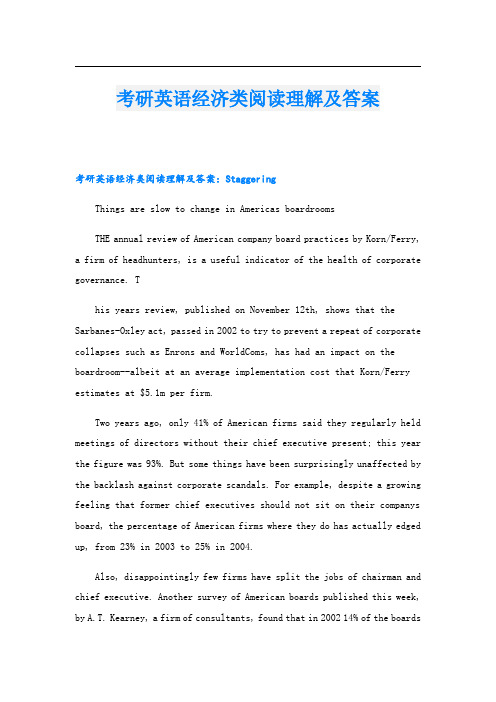
考研英语经济类阅读理解及答案考研英语经济类阅读理解及答案:StaggeringThings are slow to change in Americas boardroomsTHE annual review of American company board practices by Korn/Ferry, a firm of headhunters, is a useful indicator of the health of corporate governance. This years review, published on November 12th, shows that the Sarbanes-Oxley act, passed in 2002 to try to prevent a repeat of corporate collapses such as Enrons and WorldComs, has had an impact on the boardroom--albeit at an average implementation cost that Korn/Ferry estimates at $5.1m per firm.Two years ago, only 41% of American firms said they regularly held meetings of directors without their chief executive present; this year the figure was 93%. But some things have been surprisingly unaffected by the backlash against corporate scandals. For example, despite a growing feeling that former chief executives should not sit on their companys board, the percentage of American firms where they do has actually edged up, from 23% in 2003 to 25% in 2004.Also, disappointingly few firms have split the jobs of chairman and chief executive. Another survey of American boards published this week, by A.T. Kearney, a firm of consultants, found that in 2002 14% of the boardsof SP 500 firms had separated the roles, and a further 16% said they planned to do so. But by 2004 only 23% overall had taken the plunge. A survey earlier in the year by consultants at McKinsey found that 70% of American directors and investors supported the idea of splitting the jobs, which is standard practice in Europe.Another disappointment is the slow progress in abolishing "staggered" boards--ones where only one-third of the directors are up for re-election each year, to three-year terms. Invented as a defence against takeover, such boards, according to a new Harvard Law School study by Lucian Bebchuk and Alma Cohen, are unambiguously "associated with an economically significant reduction in firm value".Despite this, the percentage of SP 500 firms with staggered boards has fallen only slightly--from 63% in 2001 to 60% in 2003, according to the Investor Responsibility Research Centre. And many of those firms that have been forced by shareholders to abolish the system are doing so only slowly. Merck, a pharmaceutical company in trouble over the possible side-effects of its arthritis drug Vioxx, is allowing its directors to run their full term before introducing a system in which they are all re-elected (or otherwise) annually. Other companies staggered boards are entrenched in their corporate charters, which cannot be amended by a shareholders vote. Anyone who expected the scandals of 2001 to bring about rapid change in the balance of power between managers and owners was, at best, naive.--------------------------------------------------------------------------------Economist; 11/13/2004, Vol. 373 Issue 8401, p67-67, 4/9p注(1):*选自Economist;11/13/2004, p67-67, 4/9p;注(2):*习题命题模仿1998年真题text 1第2题(1),2002年真题text 2第2题(2),text 5第3题(3),2004年真题text 4第2题(4)和1999年真题text 1第4题(5);1.The Sarbanes-Oxley act is most probably about_________.[A] corporate scandal[B] corporate management[C] corporate cost[D] corporate governance2.The word “backlash” (Line 3, Paragraph 2) most probably means_________.[A] a violent force[B] a strong impetus[C] a firm measure[D] a strong negative reaction3.According to the text, separating the roles between chairman and chief executiveis________.[A] a common practice in American companies[B] what many European companies do[C] a must to keep the health of a company[D] not a popular idea among American entrepreneurs4.We learn from the text that a "staggered" board________.[A] is adverse to the increment of firm value[B] gives its board members too much power[C] has been abolished by most American companies[D] can be voted down by shareholders5.Toward the board practice of American companies, the writers attitude can be said tobe________.[A] biased[B] pessimistic[C] objective[D] critical答案:D D B A D篇章剖析本篇*是一篇议论文,对美国公司的董事会变化缓慢的情况提出了批评。
考研中英语一经济类文章答题分布和出题规律

考研中英语一经济类文章答题分布和出题规律
1.第四篇英语阅读都会有两个D选项,切不存在5个中为ABCD+X形式,5个中均有两个答案相同
2.前三篇阅读均有两篇为ABCD+X,(16和20年的均在一起),切分布有规律,17为1.3篇,18为1.2篇,19为2.3篇,从无重复,16年的仅为一篇也为20年的埋下了伏笔,20年的三篇均为,是规律中起伏。
总结:我认为政府机构总有爱好,五年计划,十年总结什么的,英语阅读的答案5年的分布分布想必在2016的某个时刻依然决定,这个也许是个彩蛋挺有意思的。
不过这些发现的基础是在,你看了4年至少三年的规律,再考虑到16至20这个特殊的年份想起来的闭环才可能发现,而运用的基础在于自身实力的强大,能做出来至少80以上的题,其实跟人的成功也一样的,在你有细心发现并且有勇气尝试的时候,必须要有你超越大部分人的能力衬托才可能给你推向顶峰,没有只靠运气和投机取巧的。
考研英语二阅读主题

考研英语二阅读主题考研英语二的阅读部分是考试中至关重要的一环,它不仅考察学生对英语语言的掌握程度,还考察学生的逻辑思维和分析能力。
在准备考研英语二的阅读时,有几个主题是考生们需要特别关注的。
首先,社会现象类的文章是常见的阅读材料。
这类文章通常会探讨一些普遍存在的社会问题,比如环境保护、教育改革、科技发展等。
考生需要能够理解文章中对这些问题的描述和分析,并能够从多个角度去思考和评价。
其次,经济类文章也是考研英语二阅读中的一个重要主题。
这些文章可能涉及全球经济趋势、市场动态、企业经营策略等内容。
考生需要具备一定的经济学背景知识,以便更好地理解文章内容,并能够对文章中的观点进行批判性思考。
科技类文章同样不容忽视。
随着科技的快速发展,这类文章越来越多地出现在考研英语二的阅读材料中。
文章可能会介绍最新的科研成果、技术革新或者对人类生活的影响。
考生需要对科技领域有一定的了解,并且能够理解文章中的专业术语和概念。
文化类文章也是考研英语二阅读中常见的主题之一。
这类文章可能会探讨不同文化之间的交流与冲突、文化传承与创新等话题。
考生需要具备跨文化交际的意识,能够理解和尊重不同文化背景下的观点和价值观。
此外,教育类文章也是考研英语二阅读中的一个重要组成部分。
这些文章可能会讨论教育政策、教学方法、学生发展等议题。
考生需要对教育领域有一定的了解,并且能够从教育的角度去分析和评价文章中的观点。
最后,健康类文章也是考研英语二阅读中不可忽视的主题。
这类文章可能会涉及健康生活方式、疾病预防、医疗技术等话题。
考生需要对健康领域有一定的认识,并且能够理解文章中关于健康问题的讨论。
总的来说,考研英语二的阅读主题广泛,涉及社会、经济、科技、文化、教育和健康等多个领域。
考生在准备过程中,需要广泛阅读相关领域的英文材料,提高自己的阅读理解能力,同时也要培养自己的批判性思维和分析能力,这样才能在考试中取得好成绩。
考研英语阅读题材
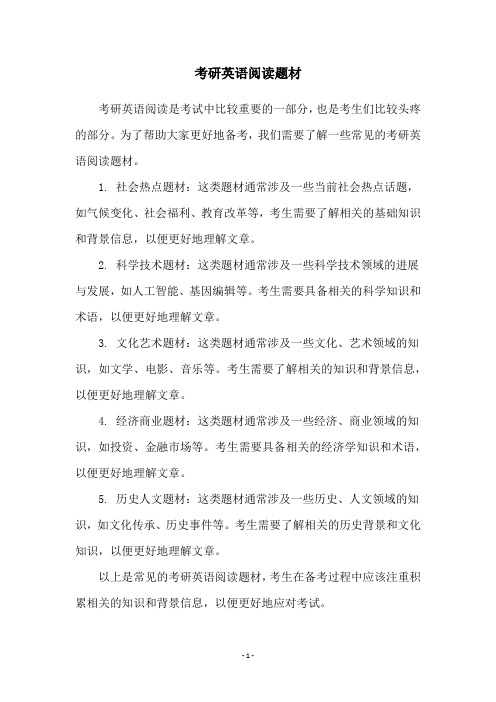
考研英语阅读题材
考研英语阅读是考试中比较重要的一部分,也是考生们比较头疼的部分。
为了帮助大家更好地备考,我们需要了解一些常见的考研英语阅读题材。
1. 社会热点题材:这类题材通常涉及一些当前社会热点话题,如气候变化、社会福利、教育改革等,考生需要了解相关的基础知识和背景信息,以便更好地理解文章。
2. 科学技术题材:这类题材通常涉及一些科学技术领域的进展与发展,如人工智能、基因编辑等。
考生需要具备相关的科学知识和术语,以便更好地理解文章。
3. 文化艺术题材:这类题材通常涉及一些文化、艺术领域的知识,如文学、电影、音乐等。
考生需要了解相关的知识和背景信息,以便更好地理解文章。
4. 经济商业题材:这类题材通常涉及一些经济、商业领域的知识,如投资、金融市场等。
考生需要具备相关的经济学知识和术语,以便更好地理解文章。
5. 历史人文题材:这类题材通常涉及一些历史、人文领域的知识,如文化传承、历史事件等。
考生需要了解相关的历史背景和文化知识,以便更好地理解文章。
以上是常见的考研英语阅读题材,考生在备考过程中应该注重积累相关的知识和背景信息,以便更好地应对考试。
- 1 -。
考研英语二 阅读 常考话题
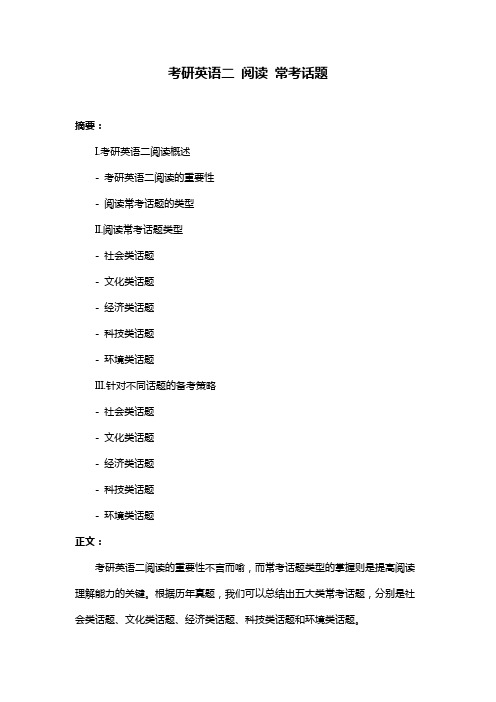
考研英语二阅读常考话题摘要:I.考研英语二阅读概述- 考研英语二阅读的重要性- 阅读常考话题的类型II.阅读常考话题类型- 社会类话题- 文化类话题- 经济类话题- 科技类话题- 环境类话题III.针对不同话题的备考策略- 社会类话题- 文化类话题- 经济类话题- 科技类话题- 环境类话题正文:考研英语二阅读的重要性不言而喻,而常考话题类型的掌握则是提高阅读理解能力的关键。
根据历年真题,我们可以总结出五大类常考话题,分别是社会类话题、文化类话题、经济类话题、科技类话题和环境类话题。
社会类话题通常涉及社会现象、社会问题以及人们的生活习惯等内容,如城市化、人口老龄化、家庭教育等。
针对社会类话题,我们需要关注社会热点问题,了解社会发展趋势,以便在阅读中更好地理解文章内容。
文化类话题主要涉及历史、地理、传统节日、习俗等内容,如中国的春节、中秋节,以及世界各国的文化传统等。
对于文化类话题,我们需要积累一定的文化背景知识,了解不同文化的特点,这样才能在阅读时快速抓住文章的核心。
经济类话题关注经济发展、经济政策以及经济现象等方面,如国内生产总值(GDP)、通货膨胀、货币政策等。
在备考经济类话题时,我们需要关注国内外经济动态,熟悉经济学术语,以便在阅读过程中更加得心应手。
科技类话题主要涉及科技发展、科技创新以及科技应用等方面,如人工智能、大数据、互联网+ 等。
对于科技类话题,我们需要了解科技领域的最新进展,掌握一些科技专有名词,这样才能在阅读时更容易理解文章内容。
环境类话题关注环境问题、环境保护以及能源利用等方面,如全球气候变化、碳排放、可持续发展等。
在备考环境类话题时,我们需要关注环保政策、了解环境问题,从而在阅读时能够准确把握文章的主旨。
总之,针对不同话题类型,我们需要积累相应的背景知识,培养相关领域的敏感度。
考研英语阅读理解A节(传统题型)分类精讲商业经济类-(二)
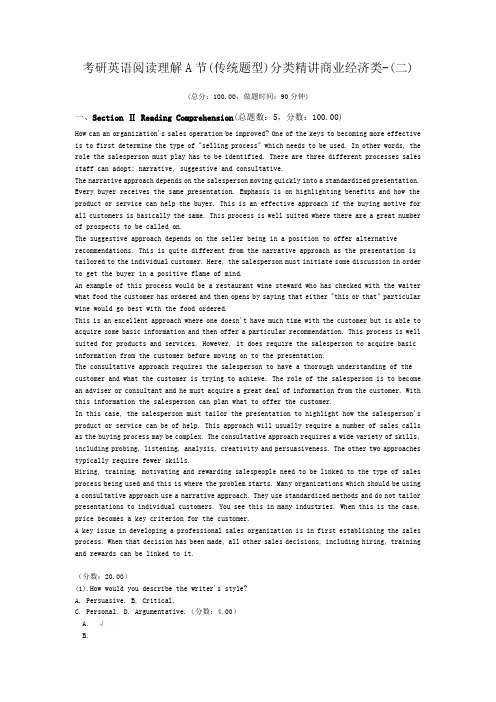
考研英语阅读理解A节(传统题型)分类精讲商业经济类-(二)(总分:100.00,做题时间:90分钟)一、Section Ⅱ Reading Comprehension(总题数:5,分数:100.00)How can an organization's sales operation be improved? One of the keys to becoming more effective is to first determine the type of "selling process" which needs to be used. In other words, the role the salesperson must play has to be identified. There are three different processes sales staff can adopt: narrative, suggestive and consultative.The narrative approach depends on the salesperson moving quickly into a standardized presentation. Every buyer receives the same presentation. Emphasis is on highlighting benefits and how the product or service can help the buyer. This is an effective approach if the buying motive for all customers is basically the same. This process is well suited where there are a great number of prospects to be called on.The suggestive approach depends on the seller being in a position to offer alternative recommendations. This is quite different from the narrative approach as the presentation is tailored to the individual customer. Here, the salesperson must initiate some discussion in order to get the buyer in a positive flame of mind.An example of this process would be a restaurant wine steward who has checked with the waiter what food the customer has ordered and then opens by saying that either "this or that" particular wine would go best with the food ordered.This is an excellent approach where one doesn't have much time with the customer but is able to acquire some basic information and then offer a particular recommendation. This process is well suited for products and services. However, it does require the salesperson to acquire basic information from the customer before moving on to the presentation.The consultative approach requires the salesperson to have a thorough understanding of the customer and what the customer is trying to achieve. The role of the salesperson is to become an adviser or consultant and he must acquire a great deal of information from the customer. With this information the salesperson can plan what to offer the customer.In this case, the salesperson must tailor the presentation to highlight how the salesperson's product or service can be of help. This approach will usually require a number of sales calls as the buying process may be complex. The consultative approach requires a wide variety of skills, including probing, listening, analysis, creativity and persuasiveness. The other two approaches typically require fewer skills.Hiring, training, motivating and rewarding salespeople need to be linked to the type of sales process being used and this is where the problem starts. Many organizations which should be using a consultative approach use a narrative approach. They use standardized methods and do not tailor presentations to individual customers. You see this in many industries. When this is the case, price becomes a key criterion for the customer.A key issue in developing a professional sales organization is in first establishing the sales process. When that decision has been made, all other sales decisions, including hiring, training and rewards can be linked to it.(分数:20.00)(1).How would you describe the writer's style?A. Persuasive.B. Critical.C. Personal.D. Argumentative.(分数:4.00)A. √B.C.D.解析:[解析] 推断题。
- 1、下载文档前请自行甄别文档内容的完整性,平台不提供额外的编辑、内容补充、找答案等附加服务。
- 2、"仅部分预览"的文档,不可在线预览部分如存在完整性等问题,可反馈申请退款(可完整预览的文档不适用该条件!)。
- 3、如文档侵犯您的权益,请联系客服反馈,我们会尽快为您处理(人工客服工作时间:9:00-18:30)。
考研英语阅读中频繁出现的经济类题型
相信考生们的通过第一轮真题的完成已经对考研阅读理解的题材有所了解,题材涉及社会科学、自然科学、人文科目,其中社会科学所占比重较大,其常涉及的领域有经济学、心理学、教育学等,今天就带各位考生一起来看一下考研英语真题中的经济类型题材真题,为考生向高分冲锋助力!
一、词汇积累
由于考研英语命题的时效性强,命题的题材高频率稳定,因此考生想要对经济类题材比其他考生掌握的更胜一筹,就要多关注诸如《经济学人》、《新闻周刊》、《时代》、《华盛顿邮报》等考研英语命题同源期刊上的文章,对词汇和长难句进行积累。
首先了解经济类术语,考生可以试着将每年真题中出现的经济类词汇加以总结,方便记忆、熟悉含义和用法。
在高频经济类词汇中,考生要注意经济类文章中的特定含义的词汇,如captive资本、interest利率、swing经济趋势。
此外还要掌握相关词组economic crisis 经济危机、financial crisis 金融危机、economic depression 经济萧条、economic revival 经济复苏、private enterprise 私营企业、enterprise in the red 亏损企业、commodity prices 商品价格、price index 价格指数、supplier 供货商、exchange rate 汇率。
二、解题技巧
要做好考研英语的经济类文章,在词汇积累以及分析句子结构的基础上,还要仔细研究真题。
即要抓住文章主旨要义,弄清作者到底在写什么。
2007年Text3一文中,分别考察了细节题、推断题和主旨题。
可以说经济类的文章考察的题目类型较多,有些“偷换概念”的地方,如the safety net偷换了原文的信息the parachute,原文中说的是“保护伞”消失了,而不是“安全网”消失了。
命题人同样也会设计“正反混淆”的题目,如原文的信息是家庭不得不为利润和股票市场的波动担忧,而更为残酷的现实是他们甚至担忧退休金无法养活自己。
只是说退休人员的安全感降低了,并不像题干中A.B 选项说的“a higher sense of security”、“less secured payments”,同样,“无中生有”即把原文中未曾提到的内容,作为题干供考生选择,也是命题的一种方式。
还需考生擦亮眼睛,通过不断的做题实践中积累宝贵的经验。
三、真题再现
2007年Text3属于经济类文章,主要介绍了处于悬崖边缘的美国中产阶级所面临的风险增加的现状,首先,作者指出了美国劳动力成分的变化导致中产阶级风险的增加。
之后作者评论道,美国总统关于健康储蓄的政策加剧了经济的风险。
最后作者指出经济的不良后果已经显现,并且可能会对政治产生影响。
下面我们来一起看一下真题原文:
During the past generation, the American middle-class family that once could count on hard work and fair play to keep itself financially secure has been transformed by economic risk and new realities. Now a pink slip, a bad diagnosis, or a disappearing spouse can reduce a family from solidly middle class to newly poor in a few months.
In just one generation, millions of mothers have gone to work, transforming basic family economics. Scholars, policymakers, and critics of all stripes have debated the social implications of these changes, but few have looked at the side effect: family risk has risen as well. Today's families have budgeted to the limits of their new two-paycheck status. As a result, they have lost the parachute they once had in times of financial setback -- a back-up earner (usually Mom) who
could go into the workforce if t he primary earner got laid off or fell sick. This “added-worker effect” could support the safety net offered by unemployment insurance or disability insurance to help families weather bad times. But today, a disruption to family fortunes can no longer be made up with extra income from an otherwise-stay-at-home partner.
During the same period, families have been asked to absorb much more risk in their retirement income. Steelworkers, airline employees, and now those in the auto industry are joining millions of families who must worry about interest-rates, stock market fluctuation, and the harsh reality that they may outlive their retirement money.For much of the past year, President Bush campaigned to move Social Security to a savings-account model, with retirees trading much or all of their guaranteed payments for payments depending on investment returns. For younger families, the picture is not any better. Both the absolute cost of healthcare and the share of it borne by families have risen -- and newly fashionable health-savings plans are spreading from legislative halls to Wal-Mart workers, with much higher deductibles and a large new dose of investment risk for families' future healthcare. Even demographics are working against the middle class family, as the odds of having a weak elderly parent -- and all the attendant need for physical and financial assistance -- have jumped eightfold in just one generation.
From the middle-class family perspective, much of this, understandably, looks far less like an opportunity to exercise more financial responsibility, and a good deal more like a frightening acceleration of the wholesale shift of financial risk onto their already overburdened shoulders. The financial fallout has begun, and the political fallout may not be far behind.
(注:划线部分为长难句)
由于涉及经济类题材的真题较多,老师在这里就不再赘述,有兴趣的考生可以把所有真题翻阅对比学习。
此外,考研英语真题的同源期刊上也存在不少经济类题材文章,考生不妨对此下一番功夫,在考试中就可以比其他考生更为快速的进入答题状态,游刃有余的应对考试。
老师在此预祝各位考生都能取得自己的理想成绩!。
